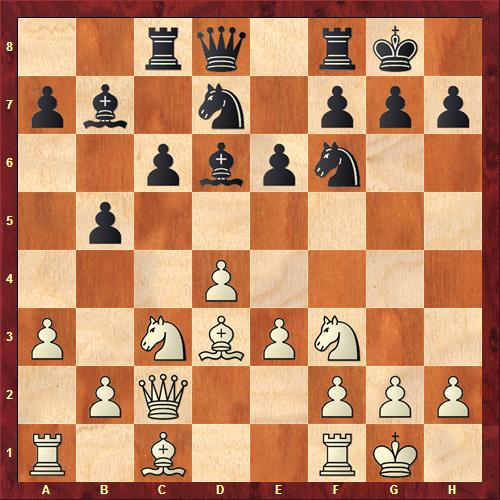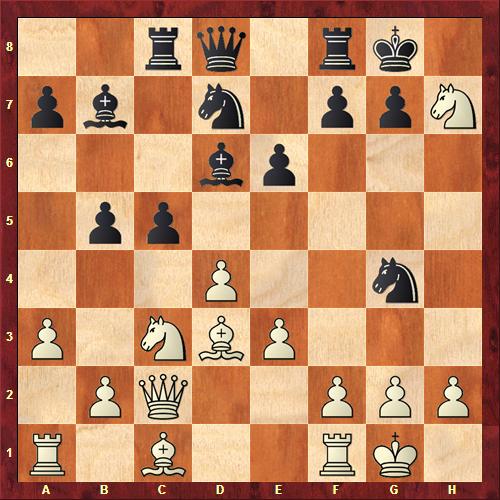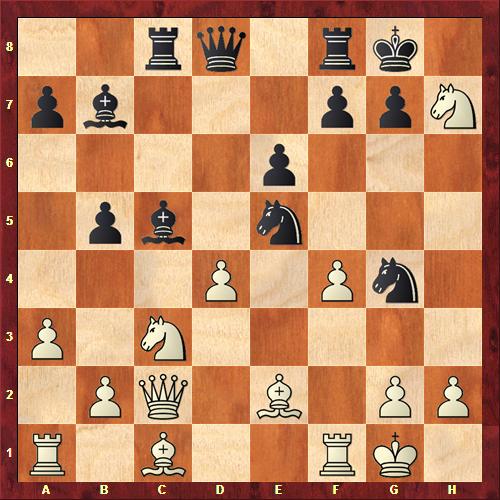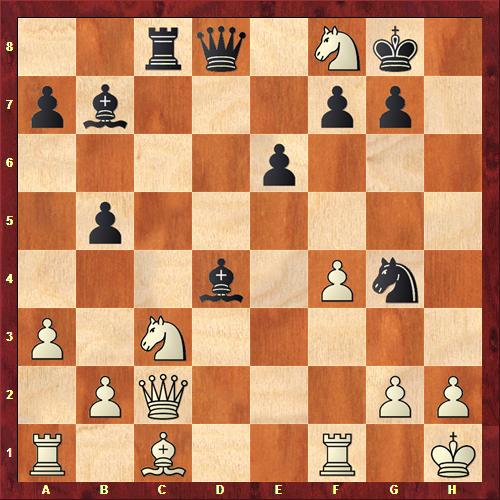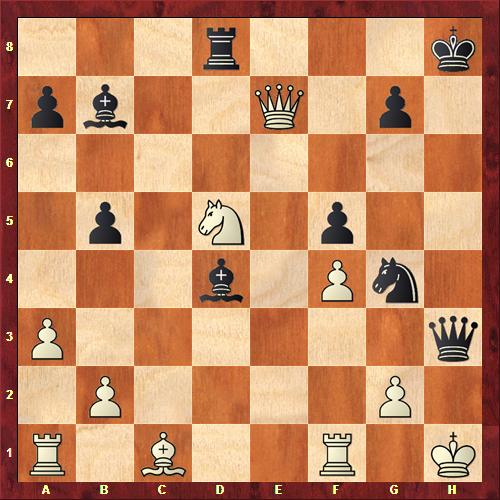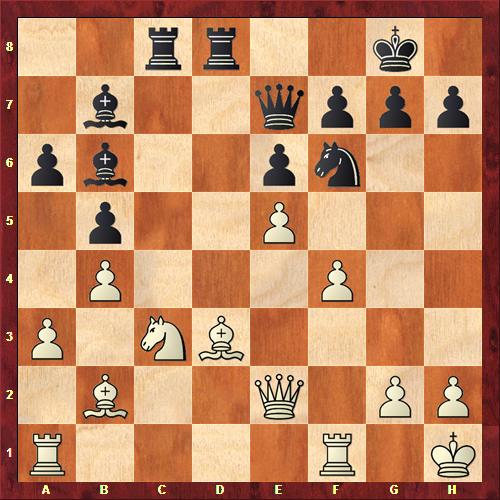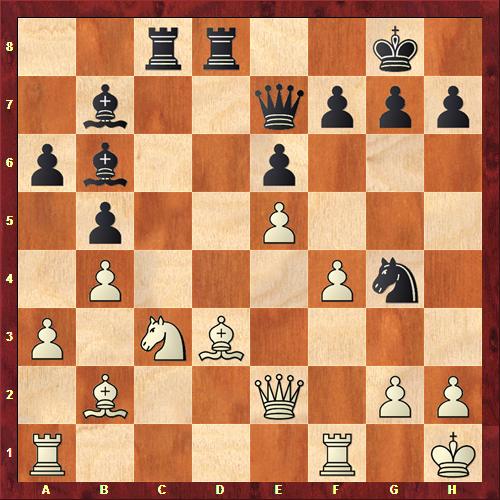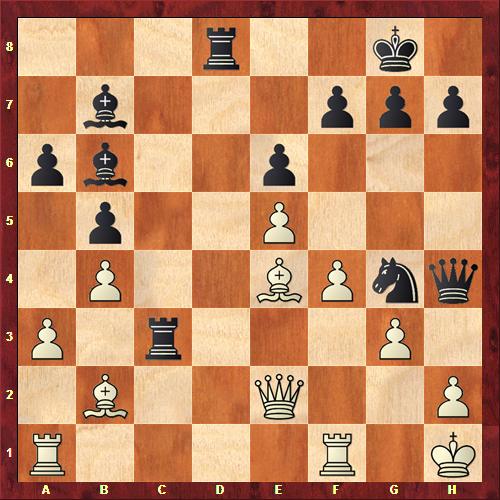"It could easily be one of my best games," said the world champion Vishy Anand after he brilliantly defeated the Armenian grandmaster Levon Aronian in the fourth round of the traditional Tata Steel Chess Tournament in the Dutch coastal town of Wijk aan Zee this week. The game would make a nice addition to Anand's award-winning collection of his well-annotated games, published byGambit Publications

Anand's victory reminds us that the ghosts of the glorious chess past are still alive. After the game, the Indian grandmaster said that it looked incredibly close to the classic duel between Gersz Rotlewi and Akiba Rubinstein, a marvelous tactical masterpiece played more than a century ago. Today, computers would have won the game differently than Rubinstein, depriving us of seeing one of the finest combinations in chess history. Let's have a look at both games.
Aronian, the last year's winner at Wijk aan Zee and currently rated number three in the world, talked about falling into an opening trap in the Semi-Slav defense, but it was not that simple. Anand acknowledged that he prepared the variation for the last year's world championship match against Boris Gelfand, but didn't say where precisely the preparation ended and the game began. His three seconds, Rustam Kasimzhanov, Radek Wojtazsek and Surya Shekhar Ganguly, used the idea after the match, but their games didn't not take the path chosen by Aronian. And Anand used it in a spectacular way.
Anand's love of the Semi-Slav defense goes way back. In 1991 in Brussel, the then 21-year-old Indian grandmaster made headlines by exchanging punches with the former world champion Anatoly Karpov during their quarterfinal Candidates match. The Semi-Slav was Anand's main defense. The score was tied before the last game.
I was there as Nigel Short's coach, guiding him to victory over Boris Gelfand. Before the last round I accidentally bumped into Karpov on the street. "Is there anything good against the Slav?" he asked desperately, but with a guilty smile. He knew I would remain silent.
The next day both Anand and Gelfand lost and were eliminated. But time heals and we saw them back last year in Moscow, playing for the world title. Vishy could not use his Semi-Slav analysis there, but it served him well now in Wijk aan Zee against Aronian.
The magical use of the long diagonal h1-a8 helped Anand to win the world championship matches against Vladimir Kramnik in 2008 (Game 3) and Veselin Topalov in 2010 (Game 12). He owns the diagonal, it is his highway to the chess crown. Aronian saw the light bishop come to life and it was a monster. And things got worse after Anand also included the dark bishop into his attack.
Aronian, Levon - Anand, Viswanathan
Wijk aan Zee 2013
1.d4 d5 2.c4 c6 3.Nf3 Nf6 4.Nc3 e6 5.e3 Nbd7 6.Bd3
The 1991 Karpov-Anand games revolved around the line 6.Qc2 Bd6 7.Be2 0-0 8.0-0 dxc4 9.Bxc4 and now 9...Qe7 or 9...a6.
6...dxc4 7.Bxc4 b5 8.Bd3 Bd6
Anand spent a lot of time choosing the bishop move over the Meran variation 8...a6 9.e4 c5.
9.0-0 0-0 10.Qc2 Bb7 11.a3 Rc8!?
The rook helps black to break with c6-c5 and white has no way to stop it. It is an improvement on 11...a6 that can be met by 12.Ng5 Bxh2+ 13.Kxh2 Ng4+ 14.Kg1 Qxg5 15.f3 Ngf6 16.e4 Qh4 17.Be3 and with strong center and a bishop pair, white has an excellent compensation for a pawn, as was played, for example in the game Anand-Aronian, Linares 2009. The roles were now reversed.
12.Ng5
Luring Anand to the same positional trap 12...Bxh2+ 13.Kxh2 Ng4+ 14.Kg1 Qxg5 and now after 15.f3 Ngf6 16.b4 white was better in Wojtaszek - Negi, German Bundesliga 2012.
The c-pawn can't be chained with 12.b4 because black can still play 12...c5! as Anand's team found out, concluding it leads to a draw after 13.bxc5 Bxf3.
And these were the reasons:
A. 14.gxf3 Nxc5! An amazing temporary piece sacrifice, equalizing the chances. 15.dxc5 Rxc5 and now trying to keep the piece leads to a draw: 16.Bb2 Bxh2+ 17.Kxh2 (17.Kh1 Nd5-+) 17...Rh5+ 18.Kg2 Rg5+ with perpetual check.
In the game Topalov -Kasimdzhanov, London 2012 white protected his king side, but lost the piece back 16.f4 Nd5 17.Bb2 Nxc3 18.Bxc3 Qc7 19.Rfc1 Rc8 and drew in 37 moves.
B. Another Anand's second, Ganguly, played 14.cxd6!? against Zherebukh in Fujairah City 2012, and after 14...Nd5 15.gxf3 Nxc3 16.f4 Nf6 17.Qb2 black could have played 17...Qd7!?, for example 18.Bd2 e5!, threatening 19...Qg4+ and equalizing. Instead he played 17...a6 and lost in 48 moves.
12...c5!
Everything breaks loose. When black's pieces aim at the white king, a couple of pawns is not important. It is stronger than grabbing the pawn: 12...Bxh2+ 13.Kxh2 Ng4+ 14.Kg1 Qxg5 15.f3 Ngf6 16.b4 and white had the edge in Wojtaszek - Negi, German Bundesliga 2012.
After the passive 12...g6 white succeeds tying black up with13.Nge4 Bb8 14.b4.
13.Nxh7
Aronian wins a pawn, but his knight gets stranded. Anand was sure that after 13.Bxh7+ Kh8 black is fine.
13...Ng4!
Rubinstein's final attacking sequence also begins with this knight leap. Anand pointed out that from the time consumption it was clear he tried to check and recheck his analysis, but it was nice to have this position as a starting point. He knew that black's chances are good and he could play with confidence. Not as good is 13...c4 14.Nxf6+ Nxf6 15.Be2 with white's edge.
14.f4
Aronian blocks the diagonal h2-b8, but Anand finds a clever way to find a new roadway for his dark bishop. The computers suggest that the position is still level after 14.h3 Bh2+! - an important check according to Anand - 15.Kh1 Qh4 black has plenty of counterplay, for example:
A. 16.d5 16...Rfd8 17.f3 (17.f4 b4 18.Ne4 c4=) 17...c4 18.Be4 Be5 19.fxg4 Nc5=;
B. 16.Be4 Bxe4 17.Qxe4 f5! 18.Qxe6+ Kxh7 19.Qxd7 Bb8 20.Kg1 (Or 20.f4 cxd4 21.Qxd4 Nf2+ 22.Kh2 Rfd8 and white can't cope with the activity of black pieces.) 20...Bh2+ 21.Kh1 Bb8 leads to a repetition.
Taking the exchange 14.Nxf8? leads to a disaster after 14...Bxh2+ 15.Kh1 Qh4 and black wins.
14...cxd4!
The exchange sacrifice weakens white's center. Anand used 30 minutes for this move. Black has fully equalized. It is a critical moment for white.
15.exd4?!
This was the right time to capture the exchange 15.Nxf8 Bxf8 16.h3! (After 16.exd4? Ndf6! white can't protect the d-pawn and after 17.h3 Qxd4+ 18.Kh1 black wins with either 18...Bc5! or 18...Nh5.) 16...dxc3 17.hxg4 with roughly equal chances, for example:
A. 17...Qh4 8.g5 cxb2 19.Qxb2 Nc5 20.Qe2 Nxd3 21.Qxd3 Qg3 22.Ra2 Bd5 23.Rc2 a5=
B. 17...Nf6 18.Rd1 (18.g5? cxb2-+) 18...Qb6=
15...Bc5!
This astonishing bishop sacrifice is designed to gain the diagonal g1-a7. It took Aronian aback.
16.Be2?
Aronian perhaps underestimated black's next move. Otherwise he would have opted for 16.dxc5!? Nxc5 with black's edge, for example:
A. 17.Qe2 - Aronian: I am worse because the bishop on b7 is such a monster. - 17...Qd4+ 18.Kh1 Nxd3 19.Qxg4 Kxh7.
B. 17.h3!? Nxd3 18.Nxf8 Qd4+ 19.Kh1 Ndf2+ 20.Rxf2 Nxf2+ 21.Kh2 Kxf8.
16...Nde5!!
Anand's pieces walk on hot embers without getting burned. The world champion is not showing off, it is the most precise way to victory. He could have tried to take different paths, for example:
A. 16...Bxd4+ 17.Kh1 Ndf6 since 18.Bxg4? Nxg4 19.Nxf8 leads to the game, but white can spoil the fun with 18.Nxf6+.
B. 16...Qh4 17.Bxg4 Bxd4+ 18.Kh1 Qxg4 19.Nxf8 Nf6 20.Qe2 Qh3 21.f5 e5 22.Rf3 Bxf3 23.Qxf3 Qh4 and white can still play.
17.Bxg4
The other knight can't be taken: 17.fxe5 Qxd4+ 18.Kh1 Qg1+ 19.Rxg1 Nf2 mate.
White gets also mated after 17.dxc5 Qd4+
A. 18.Be3 Qxe3+ 19.Kh1 Qh3, threatening 20...Qxh2 mate.
B. 18.Kh1 Nf2+ 19.Rxf2 Qxf2 and black mates either on g2 or on the first rank.
17...Bxd4+ 18.Kh1 Nxg4 19.Nxf8
After 19.Ng5 f5 20.h3 Rf6 wins.
19...f5!
Anand was proud of this move. White is lost. There was no reason to allow white to escape after 19...Qh4 20.Qh7+.
20.Ng6
Preventing the queen sortie 20...Qh4 for the time being. Black wins after 20.Qd3 Qh4 21.Qg3 Qxg3 22.hxg3 Kxf8 23.Rd1 (23.Nd1 Ke7 threatening 24...Rh8 mate.) 23...Bxc3; or after 20.Qe2 Qh4! 21.Qxe6+ Kxf8 22.Qxf5+ Kg8 23.Qe6+ Kh8.
20...Qf6 21.h3
Other moves would not help either 21.Qd3 Qxg6 22.Qg3 Nf2+-+; or 21.Ne5 Nxh2! 22.Rf2 Qh4 23.Kg1 Qg3-+.
21...Qxg6 22.Qe2
After 22.hxg4 Qh6 mates.
22...Qh5!
Threatening 23....Qxh3 mate. It is the queen, not Rubinstein's rooks, that finishes white off.
23.Qd3
The game deserved the following brilliant ending: 23.Qxe6+ Kh8 24.Nd5 Rd8 25.Qe7 Qxh3+!!
26.gxh3 Bxd5+ black mates soon.
White could have only prolonged the suffering with 23.Rf3 Nf2+ 24.Kh2 (24.Rxf2? Qxh3+ 25.Kg1 Qxg2 mate.) 24...Bxf3 25.Qxf3 Qxf3 26.gxf3 Bxc3 or 26...Nd3 and there is no doubt about black's victory.
23...Be3!
Blocking the defense of the h-pawn and threatening to mate with 24...Qxh3+. And after 24.Bxe3 Qxh3+ 25.Kg1 Qxg2 mates.
White resigned.
The game Rotlewi - Rubinstein was played at the Lodz club championship in 1907. Lodz was at that time a large textile Polish city that was a part of the Russian Empire. Rotlewi's career was cut short. He died in 1920 at the age of 31. Rubinstein became one of the best players in the world before World War I.
Andrew Soltis ranks Rubinstein's signature masterpiece as number 10 in his book The 100 Best Games of the 20th Century, Ranked, published by McFarland. It is a model game on how to act in symmetrical positions. White's inaccurate opening play is punished by three incredible rook moves, making it one of the most famous combinations.
The parallels with Anand's game are striking: the same knight leap into the attack, a bishop pair on the same diagonals bearing down on the white king at the same corner and the decisive queen sortie to the h-file.
Rubinstein is pictured around the time the game was played.
Rotlewi, Gersz - Rubinstein, Akiba
Lodz 1907
1.d4 d5 2.Nf3 e6 3.e3 c5 4.c4 Nc6 5.Nc3 Nf6 6.dxc5 Bxc5 7.a3 a6 8.b4 Bd6 9.Bb2 0-0 10.Qd2 Qe7 11.Bd3 dxc4 12.Bxc4 b5 13.Bd3 Rd8 14.Qe2 Bb7 15.0-0 Ne5 16.Nxe5 Bxe5 17.f4 Bc7 18.e4 Rac8 19.e5?
White wasted too much time in the opening and this is a losing move.
19...Bb6+ 20.Kh1
With the rooks on the open files and the bishop combo looking at the white king, something is bound to happen. Rubinstein only needs to unlock the last pieces for a powerful storm.
20...Ng4!
A signal to a decisive attack, threatening 22...Qh4. It is based on a poorly protected light bishop on d3.
21.Be4
After 21.Qxg4 Rxd3 , threatening 22...Rd2 and 22...Rdxc3, white is in dire straits.
White can't plug the diagonal h1-a8 with 21.Ne4 because of 21...Qh4! 22.h3 Rxd3! 23.Qxd3 Bxe4 24.Qb3 (Or 24.Qxe4 Qg3 25.hxg4 Qh4#) 24...Be3! finishing the same way as the Aronian-Anand game, threatening 25...Qh3 mate.
21...Qh4!
Today, computers would spoil Rubinstein's elegant combination with 21...Nxh2! , for example
A. 22.Rfe1 Rxc3 23.Bxc3 (23.Qh5 g6 24.Qxh2 Rb3-+) 23...Qh4 24.g3 Qxg3 25.Qxh2 Bxe4+ 26.Rxe4 Qxc3 27.Rae1 Rd1!! and black wins.
B. 22.Qh5.Bxe4 23.Kxh2 Bxg2! wins.
22.g3
The black pieces are ready to pounce after 22.h3 Rxc3!
A. 23.Bxc3 Bxe4 24.Qxg4 (24.Qxe4 Qg3! 25.hxg4 Qh4#) 24...Qxg4 25.hxg4 Rd3 26.Kh2 (26.Rac1 Rh3#) 26...Rxc3 27.Rac1 Rc4! and black should win.
B. 23.Bxb7 Rxh3+ 24.gxh3 Qxh3+ 25.Qh2 Qxh2 mate.
C. 23.Qxg4 Rxh3+ 24.Qxh3 (24.gxh3 Bxe4+ 25.Kh2 Rd2+-+) 24...Qxh3+ 25.gxh3 Bxe4+ 26.Kh2 Rd2+ mating soon.
22...Rxc3!!
An astonishing queen sacrifice, combining pins and deflections. White can't stop the attacking fury.
23.gxh4
Other moves don't help either:
After 23.Bxc3 Bxe4+ 24.Qxe4 Qxh2 mate.
And after 23.Bxb7 Rxg3 white's position is hopeless, for example:
A. 24.Bf3 Nxh2 wins.
B. 24.Rad1 Rxd1 (24...Rh3-+) 25.Rxd1 Nxh2 26.Qxh2 Rh3 wins.
C. 24.Rf3 Rh3 25.Rxh3 Qxh3 26.Qg2 Nf2+ 27.Kg1 Rd1+ 28.Rxd1 Nxd1+ 29.Kh1 Ng4+ 31. Kh1 Qd3! and black wins.
23...Rd2!!
The final deflection, leaving the light bishop on e4 vulnerable. The queen is simply overworked.
24.Qxd2
White doesn't have much choice. Other moves lead to mates, for example:
A. 24.Bxc3 Bxe4+ 25.Rf3 Bxf3+ 26.Qxf3 Rxh2 mate.
B. 24.Bxb7 Rxe2 25.Bg2 Rh3! 26.Bxh3 Rxh2 mate.
24...Bxe4+ 25.Qg2 Rh3!!
A clincher! Black uses a pin to deliver a pretty mate. After 26.Qxe4 Rxh2 mates.
White resigned.
 Magnus Carlsen has won the 75th Tata Steel Chess Tournament with a score of 10 out of 13, equalling Garry Kasparov's 1999 record win in Wijk aan Zee. In the final round of the tournament the
Magnus Carlsen has won the 75th Tata Steel Chess Tournament with a score of 10 out of 13, equalling Garry Kasparov's 1999 record win in Wijk aan Zee. In the final round of the tournament the world number one was a bit lucky his opponent Anish Giri (see picture) allowed a drawing combination after reaching a nearly winning position: ()see diagram) After 28.Qa3 Black would be in big trouble, but with 28.Qd6?White allows 28...Bxb3. However, Carlsen apparently was not satisfied with a draw and tested his luck one more time with28...Ne8?!. Even though 29.Qa3 is still much better for White, Giri chose to force Carlsen to execute a drawing combination:29.Qa6? Bxb3! 30.Qxf6 Nexf6
world number one was a bit lucky his opponent Anish Giri (see picture) allowed a drawing combination after reaching a nearly winning position: ()see diagram) After 28.Qa3 Black would be in big trouble, but with 28.Qd6?White allows 28...Bxb3. However, Carlsen apparently was not satisfied with a draw and tested his luck one more time with28...Ne8?!. Even though 29.Qa3 is still much better for White, Giri chose to force Carlsen to execute a drawing combination:29.Qa6? Bxb3! 30.Qxf6 Nexf6  31.axb3 Rxb3 32.Rc2 Rb1 33.Ka2 R1b4 34.Ka2. Giri's draw was enough to tie for first in the battle for best Dutchman as Loek van Wely had already gone down in flames against Sergey Karjakin. The Russian Grandmaster was well prepared for Van Wely's second Sicilian Dragon of the tournament, and when the latter embarked on a faulty plan with (see diagram) 22...a5? 23.Qh4 a4? the game came to an abrupt end with 24.Bxf7!and White soon won.
31.axb3 Rxb3 32.Rc2 Rb1 33.Ka2 R1b4 34.Ka2. Giri's draw was enough to tie for first in the battle for best Dutchman as Loek van Wely had already gone down in flames against Sergey Karjakin. The Russian Grandmaster was well prepared for Van Wely's second Sicilian Dragon of the tournament, and when the latter embarked on a faulty plan with (see diagram) 22...a5? 23.Qh4 a4? the game came to an abrupt end with 24.Bxf7!and White soon won. Battling for second place, last year's winner Levon Aronian was all set to make matters even worse for Fabiano Caruana, who had lost his last three games. Nevertheless, in the end Caruana rose to the occasion and managed to draw after 104 moves. Although his score of 8,5 out of 13 would ordinarily suffice for first place, Aronian had to settle for the runner-up position. He did not, however, have to share second place with Viswanathan Anand. The World Champion suffered a painful defeat at the hands of Wang Hao (see picture). The Chinese Grandmaster reached a slightly better endgame out of the opening and went on to exploit the advantage of a bishop over a knight in exemplary manner.
Battling for second place, last year's winner Levon Aronian was all set to make matters even worse for Fabiano Caruana, who had lost his last three games. Nevertheless, in the end Caruana rose to the occasion and managed to draw after 104 moves. Although his score of 8,5 out of 13 would ordinarily suffice for first place, Aronian had to settle for the runner-up position. He did not, however, have to share second place with Viswanathan Anand. The World Champion suffered a painful defeat at the hands of Wang Hao (see picture). The Chinese Grandmaster reached a slightly better endgame out of the opening and went on to exploit the advantage of a bishop over a knight in exemplary manner. Hou Yifan (see picture) ended the tournament with a quick theoretical draw against Peter Leko. The former Women's World Champion started the tournament as bottom seed and had a rough start in the tournament. In the end, her fighting spirit and youthful energy prevailed and with a score of 5,5 out of 13 she clearly exceeded expectations. In order to avoid last place, Ivan Sokolov gave it his all one more time, but Erwin l'Ami kept his cool and held the draw. Finally, Pentala Harikrishna tried to convert an extra pawn in an endgame against Hikaru Nakamura, but the American Grandmaster did not care for a third loss in a row and minimized the damage taking half the point.
Hou Yifan (see picture) ended the tournament with a quick theoretical draw against Peter Leko. The former Women's World Champion started the tournament as bottom seed and had a rough start in the tournament. In the end, her fighting spirit and youthful energy prevailed and with a score of 5,5 out of 13 she clearly exceeded expectations. In order to avoid last place, Ivan Sokolov gave it his all one more time, but Erwin l'Ami kept his cool and held the draw. Finally, Pentala Harikrishna tried to convert an extra pawn in an endgame against Hikaru Nakamura, but the American Grandmaster did not care for a third loss in a row and minimized the damage taking half the point. The winner of Group B only emerged after six hours of play and 82 moves when Arkadij Naiditsch finally brought Sipke Ernst to his knees in a queen endgame. Tied for first, but losing the fight for the right to participate in Group A on tie-break is Richard Rapport, who tricked Predrag Nikolic in a complicated position: (see diagram) 39.f5? c3! 40.Nxc3 Qf4 41.Ke1 Qg3! 42.Kd1 Rxc3 43.Rb8 Kg7 44.Rb7 Kf6 and White was lost. Jan Smeets was the best Dutchman in Group B in third place with a score of 8,5/13. Group C was won by Sabino Brunello with the massive score of 11 (!) out of 13. Fernando Peralta had quickly drawn his black game against Alexaner Kovchan, giving Brunello the chance to take clear first by beating Miguoel Admiraal. The best Dutchman was Robin Swinkels in third place with a score of 8,5/13.
The winner of Group B only emerged after six hours of play and 82 moves when Arkadij Naiditsch finally brought Sipke Ernst to his knees in a queen endgame. Tied for first, but losing the fight for the right to participate in Group A on tie-break is Richard Rapport, who tricked Predrag Nikolic in a complicated position: (see diagram) 39.f5? c3! 40.Nxc3 Qf4 41.Ke1 Qg3! 42.Kd1 Rxc3 43.Rb8 Kg7 44.Rb7 Kf6 and White was lost. Jan Smeets was the best Dutchman in Group B in third place with a score of 8,5/13. Group C was won by Sabino Brunello with the massive score of 11 (!) out of 13. Fernando Peralta had quickly drawn his black game against Alexaner Kovchan, giving Brunello the chance to take clear first by beating Miguoel Admiraal. The best Dutchman was Robin Swinkels in third place with a score of 8,5/13.







